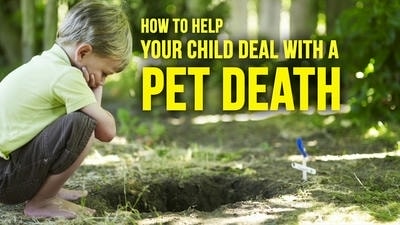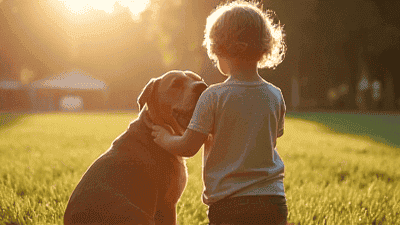
The loss of a beloved pet can be a deeply emotional and challenging experience for both adults and children. For children, who often form strong bonds with their pets, the death of a furry friend can be especially difficult to process. Pets are often seen as members of the family, and their loss can leave a significant void in a child’s life. As a parent, it’s important to guide your child through the grieving process with compassion, understanding, and support.
For children, pets are more than just animals; they are companions, confidants, and sources of unconditional love. The loss of a pet can be a child’s first encounter with death, making it a significant and formative experience. Understanding how children perceive and process grief is essential for providing the right support.
Children grieve differently depending on their age, developmental stage, and personality. Here’s how grief may manifest at different stages:

Helping your child navigate the loss of a pet requires patience, empathy, and open communication. Here’s a step-by-step guide to supporting your child through the grieving process:
When explaining the loss of a pet to your child, it’s important to be honest and clear while using age-appropriate language. Here’s how to approach the conversation:
Avoid euphemisms like "put to sleep" or "went away," as they can confuse young children. Instead, use direct language like "Our pet has died, which means they cannot be with us anymore."
Encourage your child to ask questions and express their feelings. Be prepared to answer honestly and patiently, even if they ask the same question multiple times.
Let your child know that it’s okay to feel sad, angry, or confused. Reassure them that they are not alone and that you are there to support them.
It’s important to acknowledge and validate your child’s emotions, even if they seem disproportionate or unexpected. Here’s how to do so:
Give your child a safe space to express their feelings without judgment. Listen actively and reflect their emotions back to them to show you understand.
Explain that it’s normal to feel sad, angry, or even confused after losing a pet. Share your own feelings to help them understand that grief is a shared experience.
While it’s tempting to say things like "It’s just a pet" or "You’ll get over it," these statements can invalidate your child’s feelings. Instead, validate their emotions and offer support.
Creating a tribute or memorial for the pet can help your child process their grief and celebrate the pet’s life. Here are some ideas:
Organize a small memorial service where your family can say goodbye to the pet. Invite your child to share their favorite memories or write a letter to the pet.
Encourage your child to create a memory book filled with photos, drawings, and stories about the pet. This can be a comforting keepsake and a way to honor their bond.
Planting a tree or garden in the pet’s memory can provide a lasting tribute and a place for your child to visit and reflect.
After the loss of a pet, maintaining routines and normalcy can help your child feel safe and secure. Here’s how to do so:
Continue with regular daily routines, such as mealtimes, bedtimes, and school activities, to provide a sense of stability.
Encourage your child to engage in activities they enjoy, such as sports, art, or playdates with friends. This can help distract them from their grief and provide a sense of normalcy.
Understand that grief may affect your child’s behavior or mood. Be patient and offer extra comfort and support as needed.
Encouraging your child to express their emotions can help them process their grief in a healthy way. Here are some strategies:
Provide opportunities for your child to express their feelings through creative activities like drawing, painting, or writing.
Read books or stories about pet loss to help your child understand and process their emotions. This can also provide a springboard for discussions.
If your child is struggling to cope, consider seeking support from a counselor or therapist who specializes in grief and loss.
Use the loss of the pet as an opportunity to teach your child about the grieving process and how to cope with loss. Here’s how to approach this:
Explain that grief can involve a range of emotions, including sadness, anger, guilt, and acceptance. Let your child know that it’s okay to experience these feelings at different times.
Show your child how to cope with grief in a healthy way by expressing your own emotions, seeking support, and engaging in self-care.
Help your child understand that while the pet is gone, the memories and love they shared will always remain. Encourage them to cherish these memories and find comfort in them.
While it’s important to give your child time to grieve, some families may eventually consider getting another pet. Here’s how to approach this decision:
Discuss the idea of getting another pet with your child and gauge their readiness. Avoid rushing the process, as it’s important to fully grieve the loss before welcoming a new pet.
If you decide to get another pet, involve your child in the selection process to ensure the new pet is a good fit for your family.
Explain to your child that while they may form a bond with the new pet, it will not replace the one they lost. Each pet is unique and special in their own way.
Here are some additional tips to help your child cope with the loss of a beloved pet:
Understand that grief takes time and may come in waves. Be patient and allow your child to grieve at their own pace.
Create an environment where your child feels safe to express their emotions and talk about the pet whenever they need to.
Reach out to family, friends, or support groups who understand what your child is going through. Sharing memories and experiences can be comforting.
Remember to take care of your own emotional well-being. Your ability to support your child will be stronger if you are also coping in a healthy way.

The loss of a beloved pet is a difficult experience for any child, but with your guidance and support, they can navigate the grieving process and find comfort in their memories. By being honest, validating their feelings, creating a tribute, and teaching them about grief, you can help your child cope with the loss and emerge stronger. Remember that grief is a personal journey, and it’s important to allow your child to grieve in their own way and at their own pace. With love, patience, and understanding, you can help your child heal and cherish the special bond they shared with their pet.